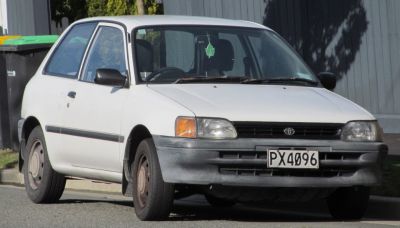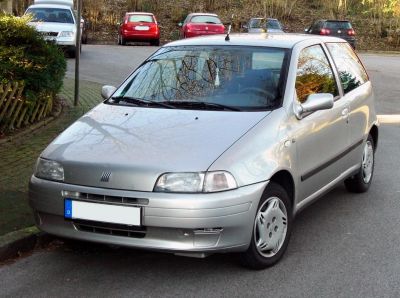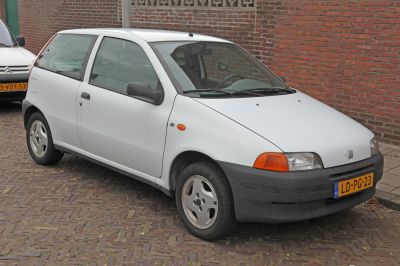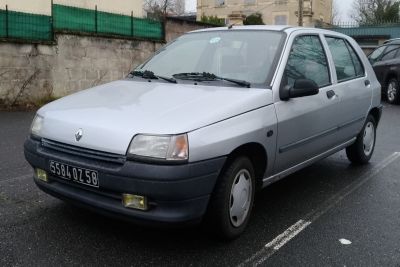 1974 Volkswagen Golf I (5-door) Dimensions, Size & Specs
1974 Volkswagen Golf I (5-door) Dimensions, Size & SpecsMeasurements of the 1974 Volkswagen Golf I, engineered for optimal performance and comfort
| Dimensions | |
|---|---|
| Length: | 3723 mm146.6 in12.2 ft |
| Width: | 1610 mm63.4 in5.3 ft |
| Height: | 1410 mm55.5 in4.6 ft |
| Ground Clearance: | 124-125 mm4.9-4.9 in0.4-0.4 ft |
| Trunk Capacity: | 368 liter13.0 cu ft |
| Trunk Capacity (Max): | 1102 liter38.9 cu ft |
| Weight Specifications | |
| Curb Weight: | 775-850 kg1709-1874 lbs |
| Maximal permitted Weight: | 1200-1300 kg2646-2866 lbs |
| Tire Specifications | |
| Rims Sizes: | 13-inch rims:
|
| Tire Sizes: |
|
The Volkswagen Golf I 5-door, produced from 1974 to 1983, marked a significant evolution in compact hatchback design and remains a classic example of efficient European engineering. This first-generation Golf 5-door hatchback features a length of 3723 mm (146.6 inches), a width of 1610 mm (63.4 inches), and a height of 1410 mm (55.5 inches), making it a relatively compact model ideal for urban driving and tight parking spaces.
Weighing between 775 and 850 kg (1,709 to 1,874 lbs) curb weight, the Golf I 5-door offered a lightweight configuration that contributed to its nimble handling and fuel efficiency. The maximum permissible weight ranged from 1200 to 1300 kg (2,645 to 2,866 lbs), allowing a balanced load capacity for everyday usage.
One of the model's highlights was its versatile luggage capacity, providing 368 liters (13.0 cubic feet) of cargo space with the rear seats upright, which expanded to an impressive 1102 liters (38.9 cubic feet) once the rear seats were folded down. This adaptability made the Golf I suitable for both small families and individuals needing extra cargo room.
With a ride height/ground clearance of approximately 124 to 125 mm (4.9 to 4.9 inches), the vehicle maintained a low center of gravity, enhancing stability and driving dynamics. The Golf I came equipped with various rim and tire size options, including rims of 4.5J x 13, 5.5J x 13, 5.5J x 14, and tire sizes like 175/70 R13, 175/50 R13, and 185/60 R14, catering to different driving preferences and road conditions.
Overall, the Volkswagen Golf I 5-door is celebrated for pioneering the compact hatchback segment with a practical design, lightweight construction, and adaptable cargo space, qualities that contributed to its long-standing popularity and influence on subsequent Golf generations.
Discover the standout features that make the 1974 Volkswagen Golf I a leader in its class
Have a question? Please check our knowledgebase first.
The Volkswagen Golf I (5-door) measures 3723 mm (146.5 inches) in length, 1610 mm (63.4 inches) in width, and 1410 mm (55.5 inches) in height. These compact dimensions made it a practical and maneuverable hatchback for urban and suburban environments during its production era.
The curb weight of the Volkswagen Golf I (5-door) ranges between 775 to 850 kg (1,709 to 1,874 lbs). This relatively lightweight construction contributed positively to fuel efficiency, making it economical to run. Additionally, the lighter weight enhanced nimble handling and agility, especially noticeable in urban driving and tight corners.
The maximum weight of the Volkswagen Golf I (5-door) ranges from 1200 to 1300 kg (2,645 to 2,866 lbs). This figure includes the vehicle's own weight plus passengers, cargo, and other load. The difference between the curb weight and maximum weight gives an estimated payload range of approximately 350 to 525 kg (772 to 1,157 lbs), indicating how much weight in passengers and cargo the car can safely carry.
The Volkswagen Golf I (5-door) offers a luggage capacity of 368 liters (approximately 13 cubic feet) with the rear seats in place. When the rear seats are folded down, this capacity significantly increases to 1102 liters (about 38.9 cubic feet), allowing for flexible storage options suitable for longer trips or larger cargo items.
The ride height or ground clearance of the Volkswagen Golf I (5-door) is approximately 124 to 125 mm (4.9 to 4.92 inches). This moderate clearance strikes a balance between providing enough space to clear common road obstacles and maintaining a low center of gravity for improved stability and handling on paved roads.
The Volkswagen Golf I (5-door) came with a variety of rim sizes, including 4.5J x 13, 5.5J x 13, 6J x 13, and 6J x 14. Tire sizes compatible with these rims included 175/70 R13, 175/50 R13, and 185/60 R14. These sizes reflect the era's standards and contributed to the vehicle's balance of comfort, handling, and road grip.
Yes, the Volkswagen Golf I (5-door), with its length of 3723 mm (146.5 inches), width of 1610 mm (63.4 inches), and height of 1410 mm (55.5 inches), fits comfortably in a standard residential garage. Standard garages typically accommodate cars up to approximately 6 meters (236 inches) in length and 2.4 meters (94.5 inches) in width, so the Golf's compact size allows for ample space around the vehicle for easy entry and exit.
The Volkswagen Golf I was conceptualized as a modern replacement for the Volkswagen Beetle, which was smaller overall and had a very different design layout. Compared to the Beetle, the Golf I offered a more compact front-engine, front-wheel-drive layout with a spacious hatchback design. Although slightly larger in length and width (Beetle was about 4,072 mm or 160.3 inches long but narrower in track), the Golf's improved interior packaging allowed for better practicality, more cabin space, and greater cargo versatility.
In comparison with contemporaneous compact hatchbacks such as the Ford Escort Mk II and the Opel Kadett C, the Volkswagen Golf I (5-door) was relatively compact yet practical. For instance, the Ford Escort Mk II measured around 3,986 mm (157 inches) in length and 1,624 mm (63.9 inches) in width. The Golf's slightly shorter length but similar width offered comparable interior space and cargo capacity, making it competitive in the compact market segment of its time.
The Volkswagen Golf I (5-door) was revolutionary in adopting a front-engine, front-wheel-drive layout that became a blueprint for future compact cars. Its hatchback design combined compact exterior dimensions with a surprisingly spacious and flexible interior. The use of simple but efficient engineering features allowed for easy maintenance and affordability. These design choices set the stage for all subsequent Golf generations, influencing countless other vehicles globally within the compact hatchback segment.
Discover similar sized cars.

| Production: | 1990-1993 |
|---|---|
| Model Year: | 1990 |
| Length: | 3652 mm143.8 in |
| Width: | 1532-1542 mm60.3-60.7 in |
| Height: | 1365 mm53.7 in |

| Production: | 1989-1996 |
|---|---|
| Model Year: | 1990 |
| Length: | 3720 mm146.5 in |
| Width: | 1600 mm63.0 in |
| Height: | 1380 mm54.3 in |

| Production: | 1971-1986 |
|---|---|
| Model Year: | 1971 |
| Length: | 3625 mm142.7 in |
| Width: | 1527 mm60.1 in |
| Height: | 1358 mm53.5 in |

| Production: | 1997-1999 |
|---|---|
| Model Year: | 1997 |
| Length: | 3760-3770 mm148.0-148.4 in |
| Width: | 1625 mm64.0 in |
| Height: | 1440-1460 mm56.7-57.5 in |

| Production: | 1993-1997 |
|---|---|
| Model Year: | 1994 |
| Length: | 3760-3770 mm148.0-148.4 in |
| Width: | 1625 mm64.0 in |
| Height: | 1450-1460 mm57.1-57.5 in |

| Production: | 1974-1983 |
|---|---|
| Model Year: | 1974 |
| Length: | 3723 mm146.6 in |
| Width: | 1610 mm63.4 in |
| Height: | 1410 mm55.5 in |

| Production: | 1990-1998 |
|---|---|
| Model Year: | 1990 |
| Length: | 3709 mm146.0 in |
| Width: | 1616 mm63.6 in |
| Height: | 1395 mm54.9 in |

| Production: | 1984-1993 |
|---|---|
| Model Year: | 1984 |
| Length: | 3685 mm145.1 in |
| Width: | 1610 mm63.4 in |
| Height: | 1410 mm55.5 in |
